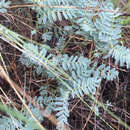Comprehensive Description
provided by North American Flora
Homalobus collinus (Dougl.) Rydb. Bull. Torrey Club
40: 53. 1913.
Phaca collina Hook. Fl. Bor. Am. 1: 141. 1831.
Astragalus collinus Dougl.; Hook. Fl. Bor. Am. 1: 141, as synonym. 1831. Astragalus syrtoides A. Gray, Proc. Am. Acad. 6: 201. 1864. Tragacantha collina Kuntze, Rev. Gen. 944. 1891.
A perennial, with a cespitose caudex; stems branched, 3-5 dm. high, shortvillous with incurved hairs; leaves 5-10 cm. long; stipules lanceolate, distinct, 3-5 mm. long, short-villous ; leaflets 1 1-23, linear or oblong, or those of the lower leaves obovate, acute at the base, obtuse to retuse at the apex, 5-15 mm. long, 2-5 cm. wide, short-pubescent on both sides with curved hairs; peduncles 5-12 cm. long; racemes 5-10 cm. long; bracts lanceolate, 3-4 mm. long; pedicels very short, shorter than the bracts; calyx villous, the tube 7 mm. long, 4—5 mm. broad, gibbous below on the upper side, the upper two teeth triangular, the lower three lanceolate, 2 mm. long; corolla pale-yellow; banner obovate, 12-14 mm. long, tapt_ring into the broad claw; wings about as long, the blade oblong, acutish, with a semisagittatc base, shorter than the long claw; keel-petals slightly shorter, the broadly lunate blade rounded at the apex, with a rounded basal auricle, a little more than half as long as the claw; pod shortvillous, stipitate, the body linear, nearly straight or slightly curved upwards, 2-2.5 cm. long, 4 mm. broad, acute at each end, the stipe about 8 mm. long; seeds obliquely reniform, fully 2 mm. long, 1.5 mm. broad.
Type locality: On the subalpine range of the Blue Mountains, Oregon. Distribution: British Columbia to Idaho and Oregon.
- bibliographic citation
- Per Axel Rydberg. 1919. (ROSALES); FABACEAE; PSORALEAE. North American flora. vol 24(1). New York Botanical Garden, New York, NY
Physical Description
provided by USDA PLANTS text
Perennial, Herbs, Stems woody below, or from woody crown or caudex, Taproot present, Nodules present, Stems erect or ascending, Stems less than 1 m tall, Stems solid, Stems or young twigs sparsely to densely hairy, Stem hairs hispid to villous, Leaves alternate, Leaves petiolate, Stipules conspicuous, Stipules membranous or chartaceous, Stipules persistent, Stipules free, Leaves compound, Leaves odd pinnate, Leaf or leaflet margins entire, Leaflets opposite, L eaflets 10-many, Leaves hairy on one or both surfaces, Inflorescences racemes, Inflorescence axillary, Bracts very small, absent or caducous, Flowers zygomorphic, Calyx 5-lobed, Calyx gibbous, inflated, or spurred, Calyx glabrous, Calyx lobes exceeding or about equal to corolla, Petals separate, Corolla papilionaceous, Petals clawed, Petals white, Petals ochroleucous, cream colored, Petals orange or yellow, Banner petal narrow or oblanceolate, Wing petals narrow, oblanceolate to oblong, Wing tips obtuse or rounded, Keel petals auriculate, spurred, or gibbous, Keel tips obtuse or rounded, not beaked, Stamens 9-10, Stamens diadelphous, 9 united, 1 free, Filaments glabrous, Style terete, Style persistent in fruit, Fruit a legume, Fruit stipitate, Fruit unilocular, Fruit tardily or weakly dehiscent, Fruit elongate, straight, Fruit oblong or ellipsoidal, Fruit coriaceous or becoming woody, Fruit exserted from calyx, Fruit inflated or turgid, Fruit beaked, Fruit hairy, Fruit 3-10 seeded, Fruit 11-many seeded, Seeds cordiform, mit-shaped, notched at one end, Seed surface smooth, Seeds olive, brown, or black.

